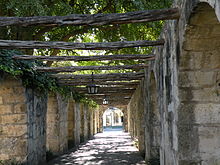- Hall
-
In architecture, a hall is fundamentally a relatively large space enclosed by a roof and walls. In the Iron Age, a mead hall was such a simple building and was the residence of a lord and his retainers. Later, rooms were partitioned from it, so that today the hall of a house is the space inside the front door through which the rooms are reached....
This:
- Deriving from the above, a hall is often the term used to designate a British or Irish country house.
- In later medieval Europe, the main room of a castle or manor house was the great hall.
- Where the hall inside the front door of a house is elongated, it may be called a passage, corridor, or hallway.
- In a medieval building, the hall was where the fire was kept. With time, its functions as dormitory, kitchen, parlour and so on were divided off to separate rooms or, in the case of the kitchen, a separate building.
On the same principle:
- Many buildings at colleges and universities are formally titled "_______ Hall", typically being named after the person who endowed it, for example, King's Hall, Cambridge. Others, such as Lady Margaret Hall, Oxford, commemorate respected people. Between these in age, Nassau Hall at Princeton University began as the single building of the then college. In medieval origin, these were the halls in which the members of the university lived together during term time. In many cases, some aspect of this community remains.
- At colleges in the universities of Oxford and Cambridge, Hall is the dining hall for students, with High Table at one end for fellows. Typically, at "Formal Hall", gowns are worn for dinner during the evening, whereas for "informal Hall" they are not.
- Many Livery Companies (e.g., in the City of London) have a Hall that is their headquarters and meeting place.
Similarly:
- A hall is also a building consisting largely of a principal room, that is rented out for meetings and social affairs. It may be privately or government-owned, such as a function hall owned by one company used for weddings and cotillions (organized and run by the same company on a contractual basis) or a community hall available for rent to anyone.
- In religious architecture, as in Islamic architecture, the prayer hall is a large room dedicated to the practice of the worship.[1] (example : the prayer hall of the Great Mosque of Kairouan in Tunisia)
Following a line of similar development:
- In office buildings and larger buildings (theatres, cinemas etc.), the entrance hall is generally known as the foyer (the French for fire-place). The atrium, a name sometimes used in public buildings for the entrance hall, was the central courtyard of a Roman house.
References
- ^ Stanford Anderson and Colin St. John Wilson, The Oxford companion to architecture, Volume 1, Oxford University Press, 2009, page 477
Rooms, spaces, and architectural elements Public areas - Airport lounge
- Auditorium
- Cafeteria
- Classroom
- Changing room / Locker room
- Conference hall
- Doctor's office
- Function hall
- Mailroom
- Library
- Lobby
- Office
- Refectory
- Restroom
- Security
- Waiting room
Passages and spaces Utility and storage - Attic
- Basement
- Box room / Carport
- Cloakroom
- Closet
- Electrical room
- Equipment room
- Furnace room / Boiler room
- Garage
- Janitorial closet
- Laundry room / Utility room
- Mechanical room / floor
- Pantry
- Root cellar
- Semi-basement
- Studio
- Server room
- Wardrobe
- Workshop
- Vault
- Wine cellar
- Wiring closet / Demarcation point
Shared residential rooms Private rooms Great house areas - Ballroom
- Butler's pantry
- Buttery
- Drawing room
- Fainting room
- Great chamber
- Great hall
- Larder
- Long gallery
- Lumber room
- Parlour
- Root cellar
- Salon
- Saucery
- Scullery
- Servants' hall
- Servants' quarters
- Smoking room
- Solar
- Spicery
- Stillroom
- Undercroft
Other areas Architectural elements Related terms - Building
- Furniture
- House
- House plan
- Rooms
Categories:- Rooms
Wikimedia Foundation. 2010.







